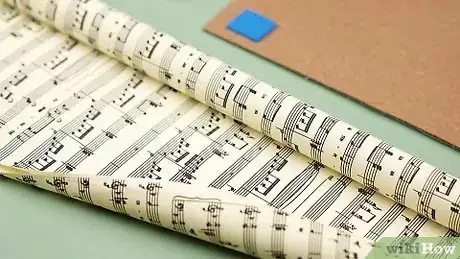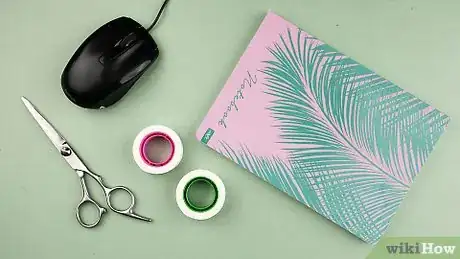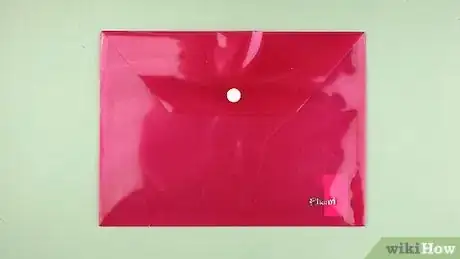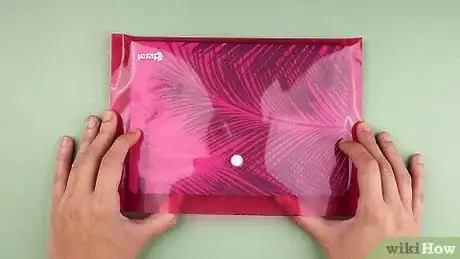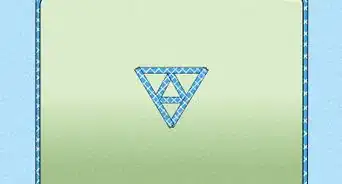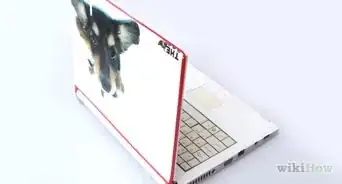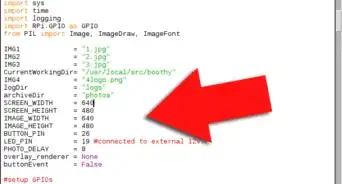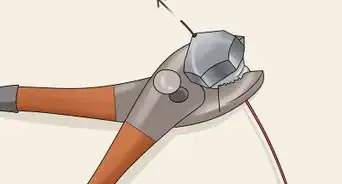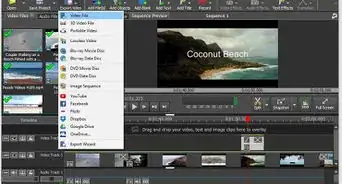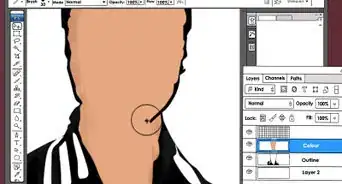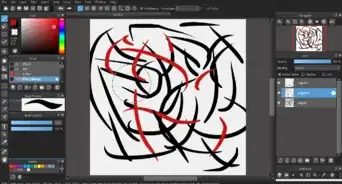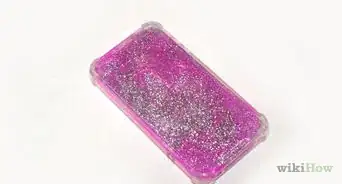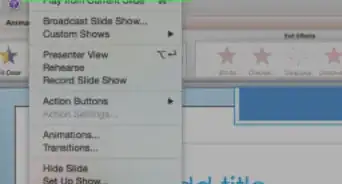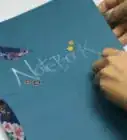This article was co-authored by wikiHow Staff. Our trained team of editors and researchers validate articles for accuracy and comprehensiveness. wikiHow's Content Management Team carefully monitors the work from our editorial staff to ensure that each article is backed by trusted research and meets our high quality standards.
The wikiHow Video Team also followed the article's instructions and verified that they work.
This article has been viewed 277,002 times.
Learn more...
Mousepads are an essential accessory for any desktop computer user. Customizing your mousepad can be fun. If you make your own, you'll be able to adjust it to your size preferences and decorate it to match your desk area.
Steps
Creating the Base of Your Mousepad
-
1Select a piece of cardboard. Measure and cut it to the size you want your mouse pad to be. A standard mouse pad is around 8” x 10”, but feel free to customize the size to your personal preference.[1]
- Use corrugated cardboard, rather than flat cardboard, because it provides a layer of cushioning.
- If you have any cardboard boxes on hand, you can simply cut the base of your pad from the side of a box.
- If the cardboard you have isn't thick enough for the mousepad you want, you can glue a few pieces of cardboard together to create your pad's base.
- Instead of cardboard, you can also use a piece of foam core.
-
2Make your base non-slip. You don't want your mousepad to slide around on your desk while you are trying to use it.
- You can use shelf and drawer non-slip liner for the bottom of your mousepad. Just cut it to the size of the base of your mousepad. You can find this type of liner in stores like Target, Walmart, Lowes, or Home Depot.
- If you don't buy the adhesive kind of liner, use glue to attach it.
- Alternatively, you can use a piece of a rug liner in the same way.
- If you want a simple, household nonstick alternative, you can use a piece of double-sided tape on each corner of your pad. Add your tape when you are completely finished constructing your pad. Simply use it to stick the pad to your desk.
- You can also use adhesive pads or putty meant for hanging posters.
Advertisement -
3Cut a sheet of thin self-adhesive foam padding. This should be the same size as your cardboard and will give your mouse a good surface to move on.
- You want to place your foam directly on top of your cardboard surface so that all the sides line up.
- After you cut the foam, remove the paper protecting the adhesive and apply it to the top of your cardboard. If the foam you find doesn't have adhesive, you'll want to glue the foam in place.
- You should be able to find this type of foam at any hobby or craft store.
- If you don't want to use foam, you can just leave the cardboard plain, as it will still function as a mousepad.
- Alternatively, you can use something like a piece of cork as this layer of your mousepad. If you have an old bulletin board, simply cut out a piece the size of your pad.
Adding the Decorative Top Layer
-
1Choose a design. The beauty of creating your own mousepad is that you can customize it to match your workspace.
- Decide if you want it to include a pattern, a solid color, or a photograph.
-
2Find your material. Once you know what you want your design to be, decide on a material for the decorative top layer of your mousepad.
- Remember that you want your mousepad to stay smooth and flat, so your mouse can move across it easily.
- For photographs, you can use simply a printed sheet of paper with your chosen image.
- When you're using a photo, you want to make sure you use a photo that is the size of your mouse pad, rather than gluing a smaller photo in the center.
- If you'd rather have a pattern, you can use wallpaper or wrapping paper. Thrift stores are a great place to find cheap remnants of wallpaper perfect for crafting.
- Fabric is also a good material for solid or patterned mousepads. You can find fabric at any local hobby store or repurpose an old cotton shirt.
-
3Cut to size. Whatever material you choose, you'll need to cut it to the size of your mousepad base.
- You want it to be the exact size of the top of your base with clean-cut edges.
-
4Attach your decorative top to your mousepad. After you cut it to size, you will want to attach your fabric or paper top to the base.
- White glue or mod podge works well for paper tops. Just use a paintbrush to spread a thin, even layer of glue onto the surface of your base, and then smooth on your top layer of paper.
- If you are using fabric, use fabric glue or a spray adhesive for the best results.
- Avoid hot glue, as this will leave lumps in your mouse pad.
-
5Cover the top with clear contact paper. The clear contact paper will protect your design and allow your mouse to move smoothly.
- First, cut your contact paper to size. Then, peel off its backing, and apply it to your mousepad. Be sure to smooth out any air bubbles.
- You can use the side of a ruler as a tool for smoothing.
- If you'd rather skip the decorative paper or fabric, you can simply use opaque contact paper with a preprinted design.
Creating a Quick Temporary Mousepad
-
1Gather your materials. To make a very simple pad, you will need a small book or similarly shaped flat object, a plastic envelope, and some tape.
- The book inside the envelope creates a nice flat surface for your mouse to glide on.
- If you don't have an envelope, you can also use a zip-lock bag.
- If you're in a real hurry, you can use a thick magazine or a book alone as a mousepad. Make sure the book you use has a smooth cover and enough surface area. Simply place the book or magazine beside your computer.
-
2Choose the exterior of your mousepad. If you have a plastic envelope, this works best. It has a smooth surface and a small amount of cushioning.
-
3Cut your envelope in half. This will make your mousepad a more manageable size for use on your desk. You can leave the envelope whole if you want a very large mousepad or want to reuse the envelope later.
-
4Insert your weight. You'll want something to put inside of your mousepad to give it weight and give your mouse something to slide around on.
- The weight should be slightly smaller than your envelope half.
- A slim book works well.
- You could also use a scrap of wood or a few small pieces of cardboard.
-
5Put your weight inside your envelope. You want it to sit comfortably inside the envelope with a bit of room on the end so you can enclose it.
-
6Tape your envelope shut. Use a few pieces of masking tape or clear tape to seal the edges of your envelope. This insures that your weight won't fall out while you're using it.
-
7Add nonslip surface. If you really need a mousepad right away, you can skip this step. However, it can be nice to ensure your pad stays in place on your desk while you use it.
- The simplest way to create a nonslip surface is to use a few pieces of double-sided adhesive to attach the pad to your desk.
- You can also use tape, poster putter, or command hook adhesive.
Community Q&A
-
QuestionCould I use hot glue instead of a nonslip shelf liner? Hot glue works best when it's dry, so I'm wondering if that could be considered as an alternative.
 Community AnswerYes, that would totally work. It's way more practical, anyways.
Community AnswerYes, that would totally work. It's way more practical, anyways. -
QuestionWhat type of fabric other than cotton can I use to make a mouse pad?
 Community AnswerYou could use silk. If you're looking for a temporary mouse pad, though, a notebook, hardcover book, or even a sheet of paper will do.
Community AnswerYou could use silk. If you're looking for a temporary mouse pad, though, a notebook, hardcover book, or even a sheet of paper will do. -
QuestionHow can I make a homemade computer mouse pad if I only have cardboard and silk?
 Community AnswerYou can glue the silk on the cardboard and that will work. However, it is ill-advised to keep that as your permanent mouse pad. Buying a good quality one is a much better idea.
Community AnswerYou can glue the silk on the cardboard and that will work. However, it is ill-advised to keep that as your permanent mouse pad. Buying a good quality one is a much better idea.
Things You'll Need
- Cardboard (corrugated is best)
- Foam sheeting with adhesive backing
- Nonslip shelf liner
- Ruler and marker for measuring
- Scissors
- Glue
- Fabric or paper of your choice
- Transparent adhesive contact paper
References
About This Article
To make your own mousepad, cut out a piece of cardboard in the size and shape you want your mousepad to be. Attach a piece of non-slip drawer liner to the back of the cardboard to keep it from sliding around on your desk. Next, cut out a sheet of self-adhesive foam padding that’s the same size and shape as the cardboard. Peel off the backing and attach the foam to the front of the cardboard base. To decorate your mousepad, cut out a piece of decorative paper or a photo in the right size and shape to fit the pad. Spread a thin layer of glue on the back of the paper and place it on top of the foam. Cover the top with a sheet of clear contact paper to protect the decoration and help your mouse move smoothly. To learn how to make a quick, temporary mousepad, keep reading!


